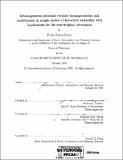Inhomogeneous potential vorticity homogenization and equilibrium in simple models of baroclinic instability with implications for the extratropical circulation by Pablo Zurita-Gotor.
Author(s)
Zurita-Gotor, Pablo, 1970-
DownloadFull printable version (22.11Mb)
Other Contributors
Massachusetts Institute of Technology. Dept. of Earth, Atmospheric, and Planetary Sciences.
Advisor
Richard S. Lindzen and Edmund K.M. Chang.
Terms of use
Metadata
Show full item recordAbstract
Baroclinic eddies are an important component of the General Circulation which regulate the extratropical climate by transporting heat and momentum. An idealization of this feedback is provided by baroclinic adjustment theories (Stone, 1978), which envision a linearly neutralized mean state. Based on the Charney-Stern condition, most baroclinic adjustment formulations propose basic states with homogenized potential vorticity. In this thesis we investigate the degree of potential vorticity homogenization in the extratropical troposphere. We show that homogenization is only observed across a shallow region around 700 mb, and propose an adjusted state with homogenized PV at the steering level alone. We demonstrate that this state can be neutral under certain conditions, and investigate its relevance for the equilibration of an idealized model. Because of the role of the PV flux as an eddy forcing of momentum, it is illuminating to describe the equilibration in terms of the redistribution of momentum. This affects both the PV gradient and the steering level of the waves, but the condition of homogenization at the steering level is very robust. In the 2D problem, a local balance can be written between the dynamical and frictional forcing of momentum. However, in the 3D problem there is an additional redistribution by a remotely forced meridional circulation. To circumvent this difficulty, we have developed a momentum-based formulation that exploits the interchangeability of momentum and temperature for quasi-balanced stratified rotating flow. By rewritting the thermodynamic equation as a momentum equation, we eliminate the forcing by the mean meridional circulation and formulate a local balance between the eddy PV flux and the non-conservative forcing of momentum. (cont.) This introduces a new variable, which we call potential momentum. The circulation can then be described in terms of the conversion between potential and physical momentum. A major simplification of this formulation is that temperature and momentum can be directly compared. For instance, the surface temperature gradient appears as a momentum source, which helps ellucidate the role of the momentum fluxes and the so-called "barotropic governor" (James, 1987) for the baroclinic equilibration. Our results suggest that mechanical friction might prevent thermal homogenization at the surface.
Description
Thesis (Ph. D.)--Massachusetts Institute of Technology, Dept. of Earth, Atmospheric, and Planetary Sciences, 2003. Includes bibliographical references (p. 199-205).
Date issued
2003Department
Massachusetts Institute of Technology. Department of Earth, Atmospheric, and Planetary SciencesPublisher
Massachusetts Institute of Technology
Keywords
Earth, Atmospheric, and Planetary Sciences.